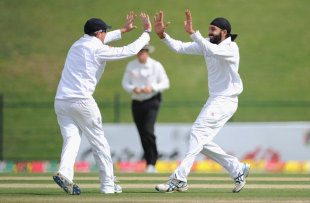by Girish Menon

The article by second generation British writer Kishan Koria applying the 'cricket test' to examine the behaviour of Britons of Asian origin was interesting and revelatory but it may be a case of blaming the victim and not the perpetrator. So, I am going to raise some issues which are never raised in the politics of Tebbit's followers.
The article by second generation British writer Kishan Koria applying the 'cricket test' to examine the behaviour of Britons of Asian origin was interesting and revelatory but it may be a case of blaming the victim and not the perpetrator. So, I am going to raise some issues which are never raised in the politics of Tebbit's followers.
Firstly, why should it be a natural assumption that if you have resided in England for years you must support the English cricket team? If England's home advantage against India is reduced to fixing the pitch to suit its bowlers then so be it. The English cricket team must earn the support of the ticket buyers with its acts on and off the pitch.
The spectator in a cricket match has paid a high price to be there. That s/he should cheer for the England cricket team was never a condition of the contract. She is a free agent and can support whoever she pleases.
The manner in which the English cricket establishment has treated players like Pietersen and Panesar gives the outsider an impression that they don't care about the views of their followers in any case. I'm sure even Bopara may be surprised at the number of times he has been in and out of the England team.
The cricket blog The Full Toss has often highlighted the uncaring way the ECB deals with the supporters of the English cricket team. So, will it not be natural for cricket lovers to express their disgust in manifold ways?
As far as citizenship in a land goes so long as residents pay taxes and obey the laws of the land then they are free to do what they like with the rest of their lives. This is usually the argument of free marketers like Tebbit, so why then do they wish to deny choice to these consumers of cricketainment with the nanny state telling them who to support in a cricket match?
So, the likes of the ECB should be happy that it is the English citizens of Indian origin who are putting the bums on stadia seats and the brown pounds in their coffers. Many English bums (pun unintended) stay away from cricket stadia for a variety of reasons including ticket prices, poor team selection policies etc. Hence the ECB should not further risk their luck by telling these high fare paying spectators who to support. Instead they should earn their support by fair minded policies and listening to the voices of their dwindling support base.
Personally, I fail the Tebbit test every time England play India and I have been unable to understand why. This is funny because in my growing years I supported the Mumbai team against other Indian teams even though my parents were immigrants from the state of Kerala (far away from Mumbai), and despite there always existing a violent campaign against immigrants in Mumbai.
It maybe out of alienation in a land where me and my family's future fortune lies. It maybe the jingoism in the highly conservative media. It maybe the 'institutional racism' referred to in the Macpherson report. It may be the 'barging of Gavaskar by Snow'; the negative lines bowled by Giles; the Zaheer Khan jelly beans incident; the failure to criticise Anderson for his foul mouthed pronouncements in the quest for victory; the failure to understand the invalidity of the predicted path in a DRS while castigating the non believer as a Luddite; or invoking the spirit of cricket argument selectively. As for the booing of Moeen Ali, a fine prospect, to my mind this appears to be a continuation of the Indo-Pak rivalry which has been carried forward by the diaspora.
However, I have also noticed periods when I begin to like the English team but then something happens and the old English superiority biases surface in the commentariat and I am driven once again to dislike the team, probably wrongly, probably not due to the players' actions. But, most importantly, the overriding reason is the brand of cricket the team plays. I have for long been a fan of the Pietersen, Botham and Gower brand of English cricket. But, so long as the clones of Boycott and Tavare dominate the approach to batting it is a trifle difficult to stay awake let alone support the England team.

